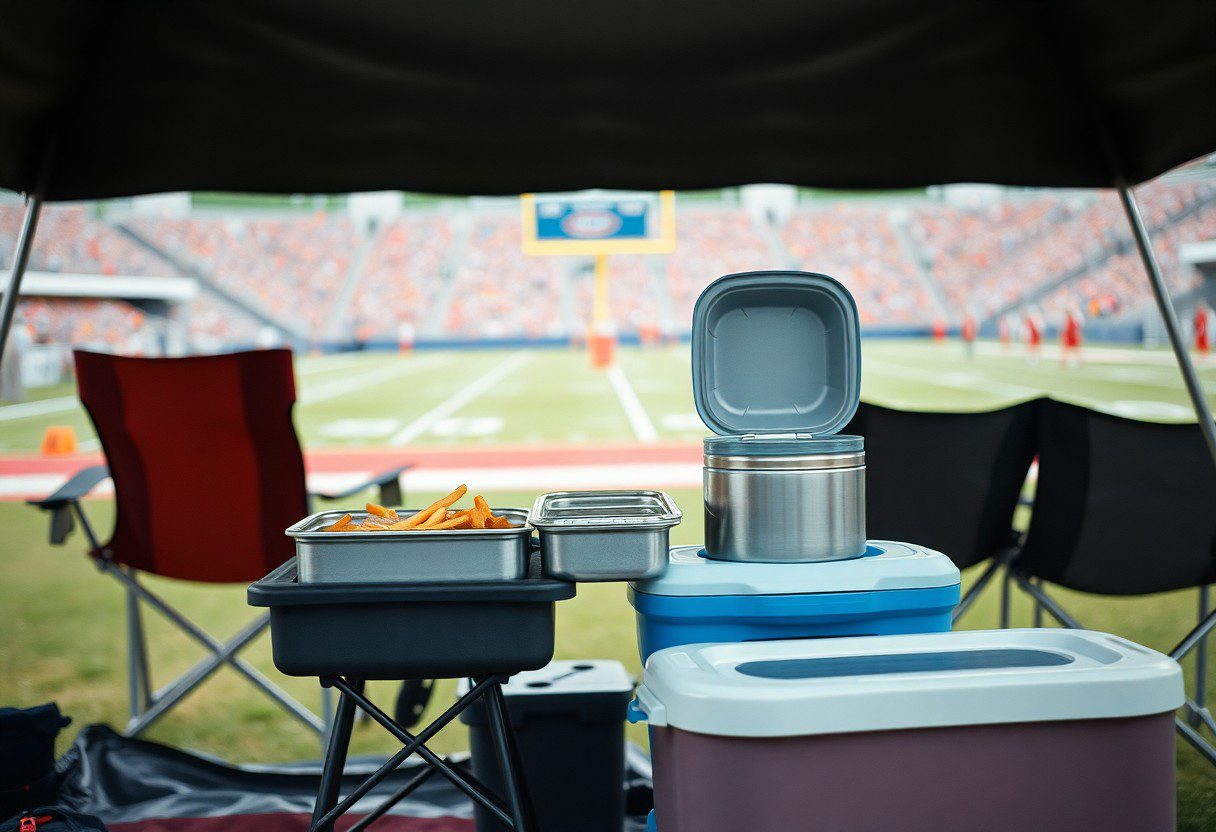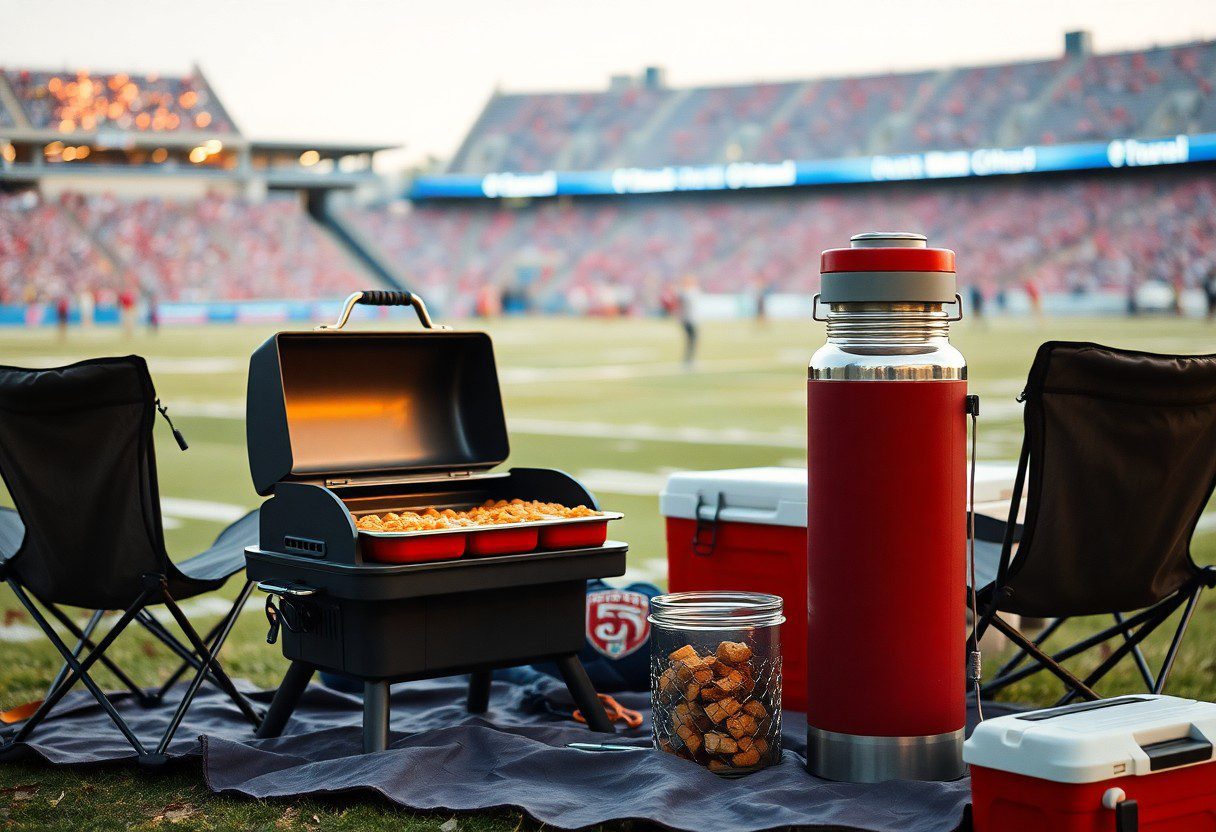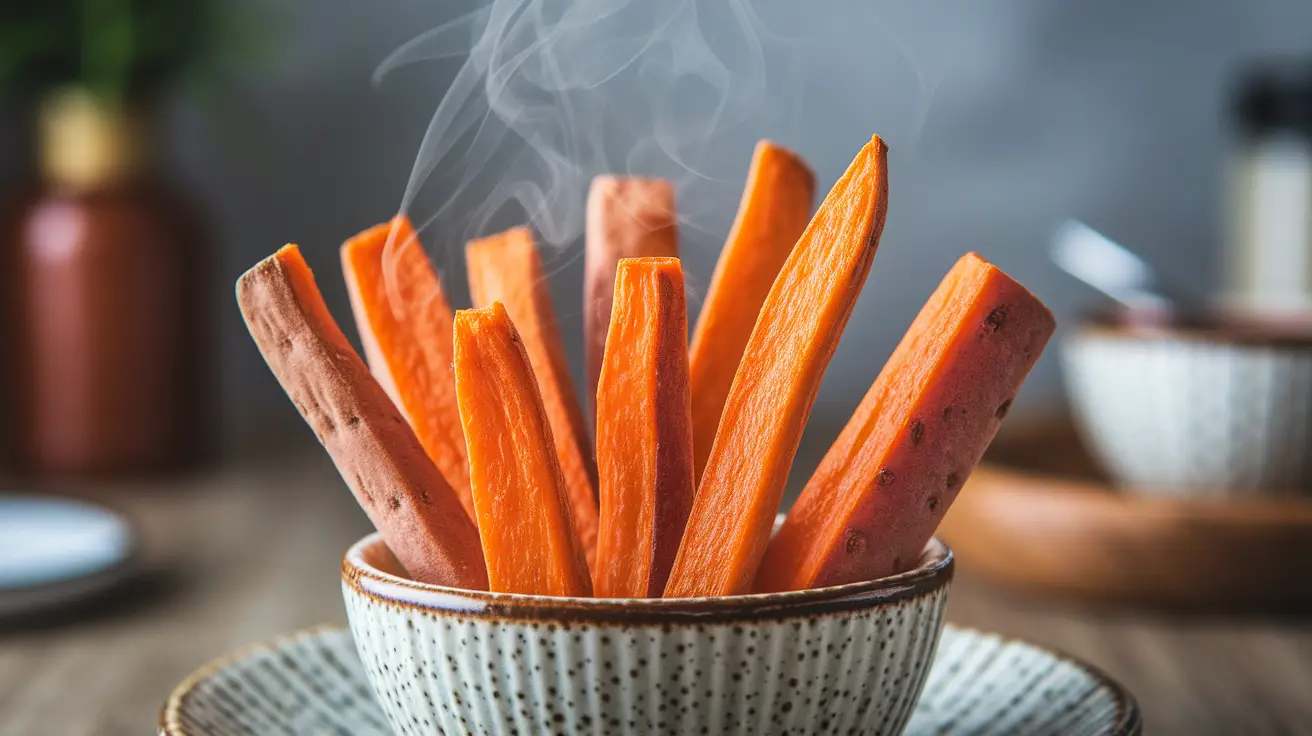Just because you’re away from home doesn’t mean your delicious tailgate food has to suffer from the cold! Keeping your dishes warm while you enjoy the game is necessary for maintaining flavor and ensuring your guests have a great time. In this guide, you’ll discover practical tips and tricks to keep your favorites like chili, hot dogs, and casseroles piping hot, all while you soak in the pre-game atmosphere. Let’s examine effective strategies that can help you master the art of tailgating with hot, enjoyable meals.
Essential Tools for Keeping Food Warm
Equipping yourself with the right tools is key to ensuring your food stays warm throughout the tailgate. This includes everything from heat retention containers to efficient cooking equipment. These tools not only help maintain food temperature but also enhance your overall grilling and dining experience. By being intentional about your selections, you can elevate the joy of sharing delicious eats with friends and family while cheering on your team.
The Role of Heat Retention Containers
Heat retention containers, like insulated food carriers or thermal bags, are indispensable for keeping your dishes warm. They trap heat effectively, making them perfect for transporting chili, soups, or even baked goods. Utilizing these containers not only preserves your food’s temperature but also keeps it safe from contamination, allowing you to enjoy your meal exactly as you intended.
Optimal Grilling and Cooking Equipment
Choosing the right grilling and cooking equipment can greatly impact your tailgate experience. High-quality grills or portable pellet smokers provide consistent heat, while features like warming racks help you keep cooked food hot without overcooking. The use of cast iron skillets—known for their heat retention—can further elevate your cooking and ensure your dishes come out perfect every time.
An ideal setup includes a portable grill with a built-in warming area, allowing you to finish cooking items while keeping others at an ideal temperature. For instance, a two-burner grill lets you manage multiple dishes simultaneously—one side grilling fresh burgers, the other keeping cooked sausages warm. Pair this with a reliable digital thermometer to ensure meats are cooked to perfection, and you’ll be ready to serve correctly cooked and delicious dishes that stay warm and flavorful until your guests are ready to dive in.
Techniques to Maximize Warmth
Keeping your food warm at a tailgate goes beyond just the right tools; employing specific techniques can make a significant difference in temperature retention. Utilizing pre-heating strategies, insulating materials, and effective covers can all contribute to a successful tailgate experience. These methods not only prolong the warmth of your meals but also enhance flavor and presentation, making your spread a hit among fellow fans.
Pre-heating Strategies for Food Items
Before you even head to the tailgate, consider pre-heating your dishes. If you’re bringing chili or soup, warm it up on the stove and transfer it to your insulated containers. For dishes like casseroles, consider cooking them the day before and letting them sit covered in a warm spot before serving. This simple strategy keeps your food at optimum temperature during transport and ensures the first serving is just as hot as the last.
Use of Insulating Materials and Covers
Once you arrive at your tailgate location, utilizing insulating materials and proper covers plays a vital role in maintaining warmth. Layered coverings, such as aluminum foil and towels, provide excellent insulation for various food items. Insulated bags specifically designed for hot items can also be a game-changer, as they retain heat much longer than standard containers. These materials not only prevent heat loss but can also protect your dishes from any chilly outdoor breezes.
Insulating materials like thermal wraps, thick blankets, or even dedicated food warmers can be incredibly effective at maintaining the temperature of your dishes. For example, wrapping a pot of hot soup in a thick towel can keep it steaming, while placing it in an insulated bag will trap even more heat. You can also consider using disposable aluminum trays with lids; they retain heat better than regular glass or ceramic dishes, making them an ideal choice for tailgating. These materials not only aid in warmth retention but can also make clean-up easier, allowing you to enjoy the game hassle-free.
Creative Serving Solutions
Utilizing creative serving solutions not only keeps your food warm but also adds flair to your tailgate experience. Consider using attractive serving platters or trays that are insulated or offer warming features. Designate each dish with a sign for easy identification, and use themed decorations to enhance the visual appeal. These innovations elevate the atmosphere and ensure your culinary masterpieces garner the attention they deserve while remaining at a perfect serving temperature.
The Benefits of Chafing Dishes and Electric Warmers
Chafing dishes and electric warmers are excellent tools for any tailgater looking to serve warm food. Chafing dishes allow you to use heated water to keep your food at the optimal temperature without direct heat, preventing overcooking. Electric warmers provide consistent heat and can accommodate various dishes simultaneously, perfect for larger gatherings. By using these serving solutions, you’ll not only keep your food warm but also maintain its quality and presentation.
Tactical Use of Foil and Towels
Utilizing foil and towels is a simple yet effective technique to retain heat. Wrapping dishes tightly in foil minimizes heat loss, while using towels creates additional insulation. The combination effectively traps steam, providing a warm environment for your food to stay cozy. This method is particularly useful for items such as baked potatoes, casseroles, or grilled meats, where moisture retention is vital for flavor and texture.
Foil is an excellent insulator that reflects heat back toward your food, keeping it warm longer. For added effectiveness, wrap your food in multiple layers of heavy-duty foil. Then, wrap the entire dish in towels, which serve as another layer of insulation. This dual-layer tactic allows your dishes to stay warm for an extended period—even amidst cooler outdoor temperatures. Additionally, this method is budget-friendly, using items easily found in your kitchen, enabling you to focus resources on your delicious tailgate spread.
Temperature Monitoring Tips
Maintaining the right temperature for your tailgate food is non-negotiable for ensuring safety and flavor. Here are some practical tips:
- Use food thermometers to keep track of internal temperatures.
- Check temperature readings every hour on hot foods.
- Store perishable items in cooler areas with ice packs or ice.
- Implement a rotation system for food items to prevent overexposure to warmth.
Assume that consistent monitoring will keep your delicious dishes safe to eat and ready for your guests.
Temperature Guidelines
| Food Type | Recommended Temperature |
|---|---|
| Poultry | 165°F |
| Ground Meats | 160°F |
| Reheating Leftovers | 165°F |
| Hot Holding | 140°F or above |
Importance of Food Thermometers
Using a food thermometer not only guarantees that your dishes reach safe internal temperatures but also enhances flavor and texture. This instrument provides immediate feedback, allowing you to adjust cooking times and methods accordingly. Whether it’s a thick steak or delicate poultry, a thermometer ensures that you avoid undercooking and maximize every bite.
Methods for Best Practices in Temperature Maintenance
Effectively managing temperatures during your tailgate requires a multi-faceted approach. Keep hot foods in insulated containers and use double-walled coolers to maintain heat. Keep your grill on a low setting to keep dishes warm without further cooking them. Serve food in small batches, allowing you to replace items as they cool off. This will help sustain a pleasant eating experience.
Best Practices for Temperature Maintenance
| Method | Description |
|---|---|
| Insulated Containers | Airtight to keep heat trapped, maintaining temperatures effectively. |
| Low Heat Grill | Use for maintaining warmth without additional cooking. |
| Batch Serving | Keep food rotating by serving smaller quantities. |
| Covering Food | Use lids or foil to retain heat while serving. |
Following these methods transforms your tailgate into a safe and enjoyable feast. Keeping rotisserie chicken or BBQ ribs at the right temperature using insulated containers allows you to enjoy succulent flavors without the worry of foodborne illness. Pair this with a low heat grill to maintain warmth, and your guests will appreciate not only the taste but the overall safety of the meal.
Safety Practices
| Tip | Description |
|---|---|
| Check Temperatures Regularly | Ensure you test food temperatures every hour. |
| Prepare Ahead | Cook and heat food before leaving for the tailgate. |
| Use Separate Utensils | Avoid cross-contamination by using different utensils for raw and cooked items. |
| Keep It Covered | Cover food while it sits to maintain warmth and hygiene. |
Tailgating Logistics: Planning for Success
Strategic planning is the backbone of a successful tailgate. From determining your setup location to ensuring you have enough supplies, preparation enhances your overall experience. Consider factors like the weather, venue rules, and your group size to create a seamless event. Mapping out your space will allow you to optimize food placement, seating, and social areas, ensuring that you can easily serve food and engage guests all while maintaining warmth.
Ideal Menu Selection for Longevity
Choosing the right menu is key to sustaining warmth and flavor throughout your tailgate. Opt for hearty dishes that hold their heat well, such as chili, stews, or baked casseroles. Incorporating items that naturally retain warmth like stuffed peppers or roasted vegetables can contribute to longer-lasting enjoyment. Additionally, selecting foods that can be easily reheated, such as meat skewers and grilled sandwiches, allows you to combat any outdoor temperature drops effectively.
Coordinating Timing and Element Management
Effective timing and management of cooking elements are vital for keeping your food warm. Stagger cooking times to facilitate a smooth flow of serving hot dishes as they come off the grill or stovetop. If utilizing various heat sources, like a grill and portable stove, synchronize your efforts to maximize efficiency. Preparing items in advance, such as marinating proteins or pre-chopping veggies, can streamline the cooking process and maintain focus on keeping everything hot as you serve.
Establishing a coordinated timeline helps you maintain warmth while managing diverse cooking elements. For instance, initiate cooking proteins first, as they often require the most time. Follow with side dishes that can be kept warm on a simmer or in insulated containers. Utilizing a digital timer can assist in tracking cooking times, ensuring no dish is left unattended and cooling down. This organized approach not only allows for hot and tasty food but also ensures you and your guests enjoy a well-timed feast amid the festivities.
Conclusion
The key to keeping your food warm at a tailgate is preparation and the right tools. You should invest in insulated food carriers, portable heaters, or grills that maintain heat. Always preheat your dishes and use aluminum foil to cover food, which helps trap heat. Bring along hot packs for additional warmth, and try to minimize how often you open containers. By following these tips, you can ensure that your food stays delicious and warm, allowing you to enjoy your tailgate experience to the fullest.
FAQ: How to Keep Food Warm at a Tailgate
Q: What are some effective methods to keep food warm during a tailgate?
A: There are several effective methods to keep food warm at a tailgate. One popular option is to use insulated containers, such as thermos or cooler bags that are designed to retain heat. Aluminum foil can also be used to wrap dishes, helping to keep them warm for longer periods. Additionally, you can use portable slow cookers or electric warming trays with a power source, if available. Finally, disposable chafing dishes can be heated with sterno fuel cans to maintain the temperature of food throughout the event.
Q: How long can food remain warm using a cooler?
A: When using a high-quality insulated cooler, you can keep food warm for several hours, typically between 4 to 6 hours, depending on the cooler’s quality and the temperature of the food when placed inside. Pre-heating the cooler with hot water before adding food can help enhance the cooling performance, ensuring that your food remains warm for an extended period.
Q: Should I cover food to keep it warm, and if so, what should I use?
A: Yes, covering food can significantly help maintain its temperature. Using aluminum foil is a simple and effective solution, as it traps heat while allowing steam to escape, preventing moisture loss. Alternatively, you can use lids from pots and pans or as a last resort, place a thick towel over the food containers to help insulate and keep the heat in.
Q: Can I use a grill to keep food warm at a tailgate?
A: Absolutely! A grill can be an excellent way to keep food warm during a tailgate. You can set it to low heat or use indirect heat by placing food on the cooler side of the grill. Make sure to keep the lid closed to retain the warmth. However, it’s important to monitor food temperatures to ensure they stay above safe eating thresholds.
Q: Is it safe to keep food out for extended periods at a tailgate?
A: Food safety guidelines recommend that cooked food should not be left at room temperature for more than 2 hours. To ensure safety, keep hot foods at a temperature above 140°F (60°C) using the methods discussed. If temperatures drop below this threshold, it’s advisable to throw away the food to prevent any risk of foodborne illnesses.





